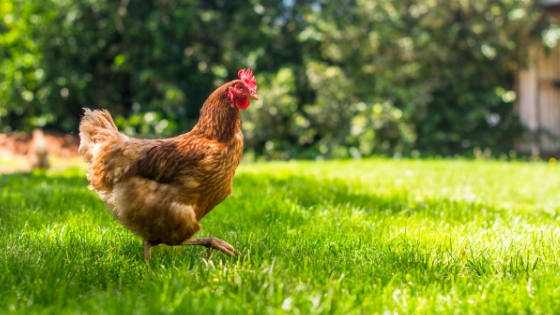People are familiar with mammal anatomy. After all, we are one. Dogs and cats are common companions and have body features, like hair and digestive and reproductive systems somewhat similar to humans.
Birds are different. They’re modern-day dinosaurs. Whether they’re a Rhode Island Red chicken or a chickadee snatching sunflower seeds from a backyard feeder the anatomy of birds varies greatly from familiar mammals.
Both types of animals have muscles and skin, but a bird’s feathers, digestive and reproductive system are very different from mammals. From the outside to the inside of their bodies here are how birds, especially chickens. Special and unique functions work.

Feathers
Only birds have feathers. They are strong, vary in color and texture, and offer protection from injuries and the weather. They enable flight, and often sport fantastic colors and patterns that may be useful in attracting a mate. Feathers have a single central shaft with barbs that hold fibers together like Velcro. Stiff wing feathers help a bird get and stay airborne, while inner, downy feathers are the most efficient insulation ever discovered. On frigid winter nights a hen’s fluffy inner feathers keep her warm while her human owners snuggle under a toasty quilt filled with goose down.
Skin
American chicken breeds, like New Hampshire Reds, usually have yellow skin and shanks. European breeds, like Orpingtons, sport white skin while some unusual breeds, especially Asian ones, have black skin.
Muscles
Chickens, like all birds, have powerful muscles that help them do something mammals (except bats) can’t do – fly. In the bird world chickens are relatively poor fliers compared with orioles and hummingbirds that migrate thousands of miles, but most breeds can at least get airborne and some can easily flap over a fence. Chickens can run like the wind, thanks to their powerful leg muscles. The powerful bulky muscles that help chickens fly and run are large and tasty. Perhaps that’s why people domesticated them from wild jungle fowl thousands of years ago.
Digestive System
A chicken’s digestive system is far different from a mammals. Most mammals chew their food. Not birds. They can’t. A chicken never needs to visit the dentist since they lack teeth. To grind up tough seeds they borrow “teeth” from the ground.
Chickens eagerly swallow pebbles that pass through their throat and lodge in the gizzard. Strong muscles churn these rocks against tough corn kernels and grind them into a moist slurry which passes into the stomach. Food nutrients then flow into the blood from the stomach and intestines. Indigestible items pass through the cloaca as droppings. When it comes to excrement birds one up mammals. They don’t produce urine. Instead, waste minerals coat the outside of moist droppings. Since they don’t urinate, they need no urethra.
Where The Eggs Come From
A bird’s cloaca serves triple duty. Waste passes out of it; a rooster’s sperm enters into it to fertilize forming eggs inside her. Then, when her egg is fully formed, it passes out of her cloaca into the nest blunt side first.
Senses
Chickens are blessed with outstanding eyesight far keener than a human’s. Their ability to hear is superb. They can touch, smell and taste but perhaps not as well as enjoyed by people and many other mammals. Combined, these senses help them find food as they wander around the yard, and that keen eyesight helps them spot a person bringing them treats.
Chickens aren’t dumb clucks. They’re smart and have bodies that let them thrive under rugged conditions and produce tasty meat and eggs for people to enjoy.